Travel & Outdoors
What It’s Like to Sail the Chesapeake on a Baltimore Clipper Ship
“Imagine finding yourself aboard a ship you’ve heard about for years, embedded into a crew of modern-day ordinary-life privateers, going bonkers just staring at the water in the middle of the night,” writes Amy Scattergood, a recent ‘Pride of Baltimore II' guest crew member.
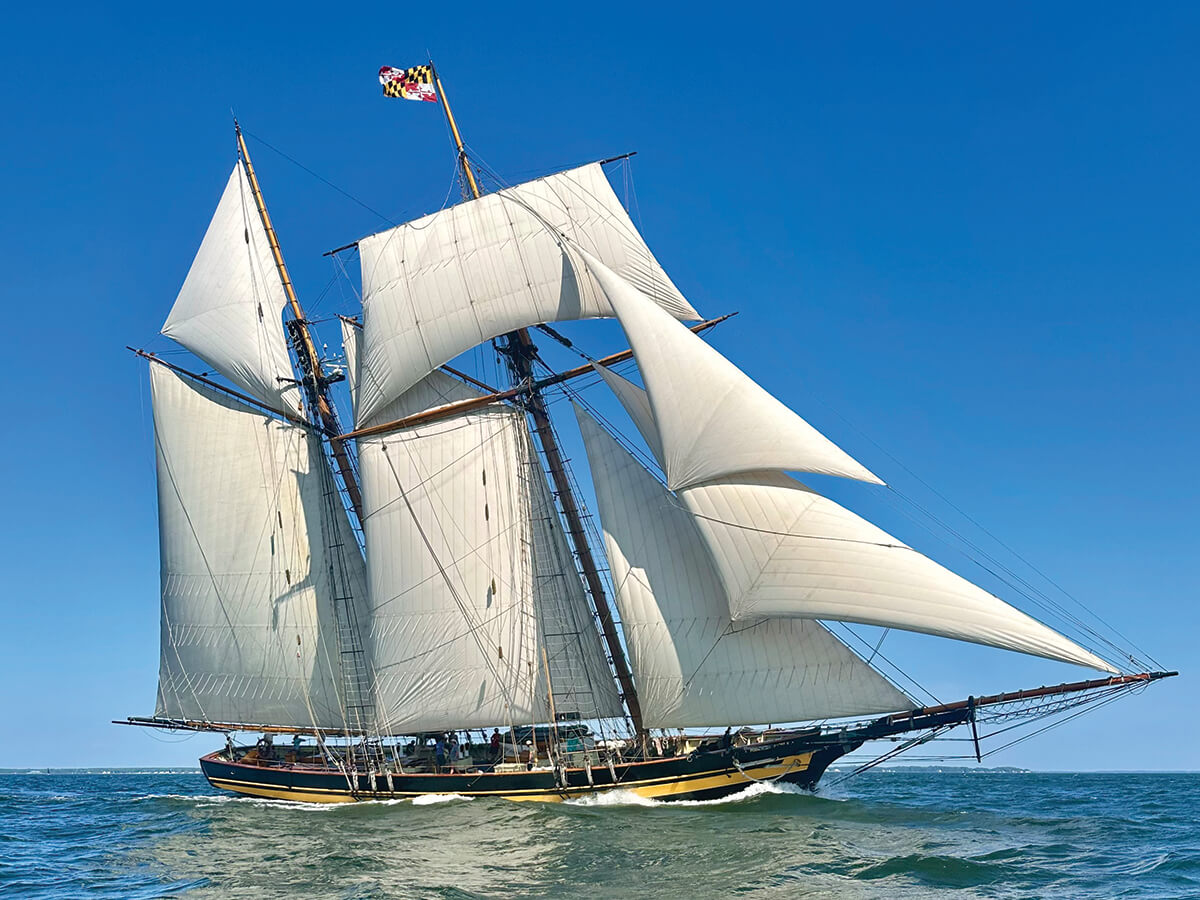
It’s after midnight, but the stars above the Chesapeake illuminate the mainsail of the Pride of Baltimore II like the wing of an enormous pale bird, the rigging intersecting the night sky in some complex geometry, tying sky to boat to water. As the crew moves around the deck, fastening the lines and coiling ropes, and as the captain studies our direction, I’m stretched out along the smooth wood atop the rear cabin house to watch the stars and listen to what’s left of the wind, struck by the beauty of the late evening hour and of the boat itself, a wooden topsail schooner that towers 110 feet up into the night.
Just a few minutes before, we’d cruised beneath the Bay Bridge, the outline of the traffic in the dark evoking both roadside neon and old-world ghosts. And although the tall double masts cleared with plenty of room to spare, it had seemed impossible that they would, as if the juxtaposition of 1812-era wooden clipper ship and 20th-century steel-and-concrete infrastructure was too incommensurate to grasp.
This feeling of disjointedness has been a hallmark of the trip, a three-day sail from Cambridge, on Maryland’s Eastern Shore, up the Chesapeake to Havre de Grace on a reproduction of the renowned clipper ships that were constructed in and sailed out of Baltimore two centuries ago.
The captain calls out to the crew, a group of 10 men and women, professional sailors of various ages and backgrounds who had signed up for a full-time stint of at least six months—some for their first experience sailing a tall ship, others who’d been sailing them for decades. The sails are lowered, the 700-lb. anchor unwound and dropped into the relative shallows of the Chester River. A night lantern is hoisted overhead. Brightly colored lights also go up, strung atop the masts.
“Why not party lights?” asks Shevawn Innes, the first mate, her long hair wound into a messy bun, tattoos down her arms. “Spread joy recklessly.”
Two or three deckhands climb along the jib, folding the topsail into pleats and tying it down like a massive umbrella. When the sails are secure and all the ropes coiled—the Pride has 11 sails and nearly two miles of ropes—captain Jeff Crosby gives a brief summation of the day’s sail and an overview of what’s coming tomorrow. Released for the night, a few crew members linger on deck, as do the three of us who’ve signed on to guest crew, appreciating the view of the calm water and the lights ashore.
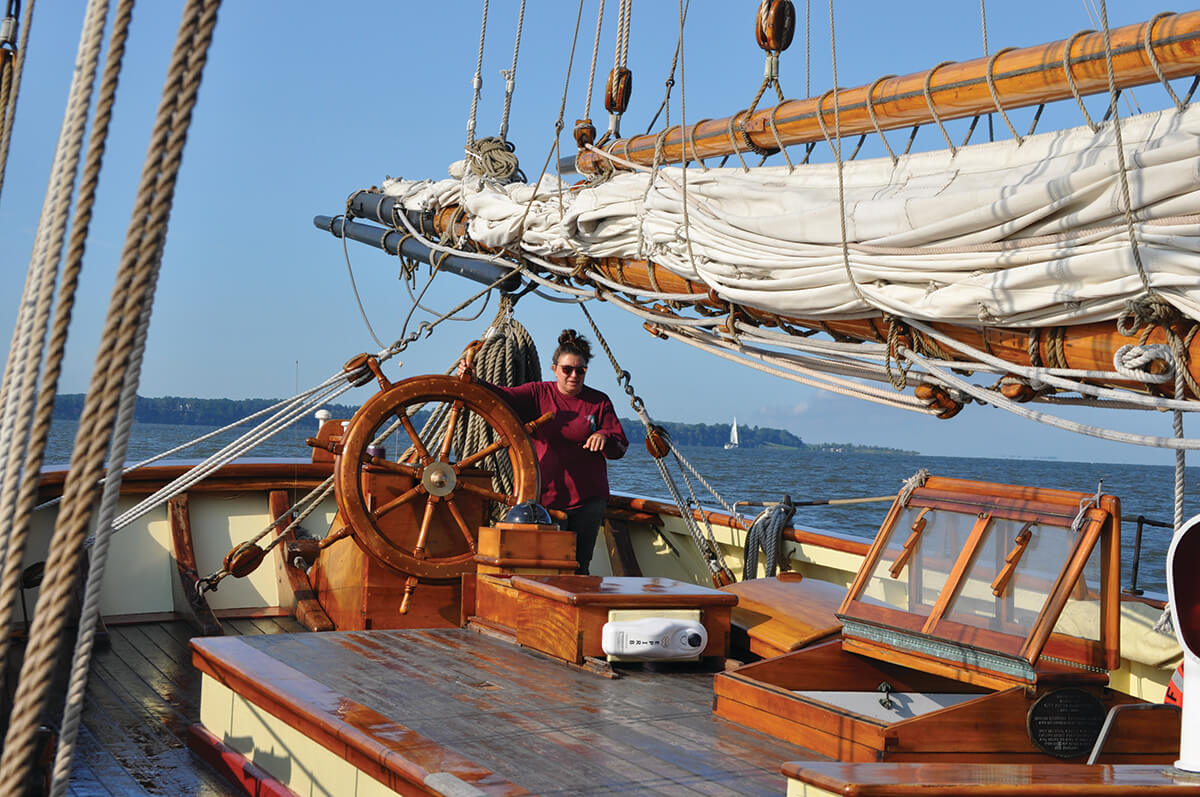
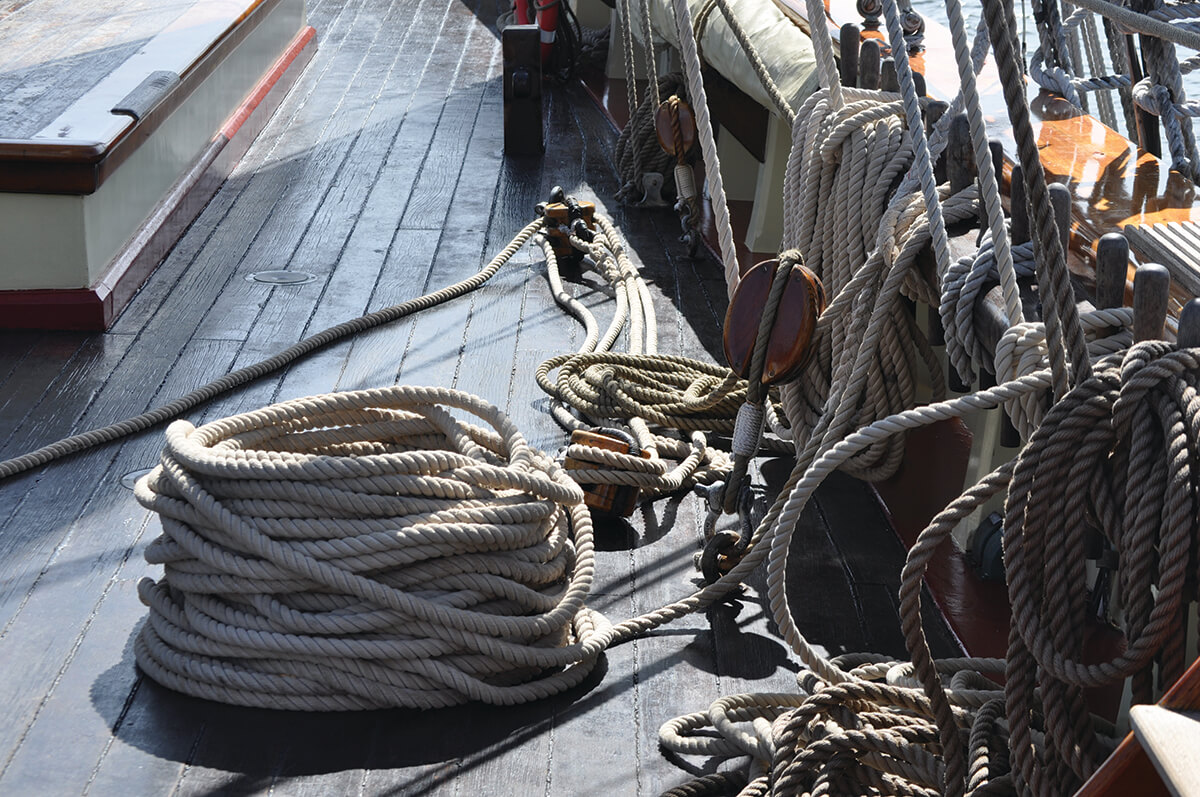

Imagine finding yourself aboard a ship you’ve heard about for years, embedded into a crew of modern-day ordinary-life privateers, going bonkers just staring at the water in the middle of the night. Not an easy job, sailing.
The Pride offers guest crew positions for most of her journeys, short sails like this one, or the longer voyages from her Inner Harbor home to Norfolk, Boston, New York, around the Maritimes and up the St. Lawrence to the Great Lakes, even to Bermuda.
Pride is a nonprofit that gets its funding from state grants, donations, and this program. For a fee that can range between $350 to a few thousand, anyone can come aboard as a working passenger bunking in the cabins, eating with the crew, and helping do things like keep watch, set and lower the sails, assist with routine maintenance, haul and coil ropes, and even take the helm, albeit under the watchful eye of actual crew members.
Depending on wind and weather—and the utter impossibility of knowing what can happen on any journey aboard a wooden sailing ship—this can mean hauling ropes in a rainstorm or climbing 50 feet overhead to secure windblown sails while hitched to a rope ladder with a carabiner. That said, our trip to Havre de Grace was less Sebastian Junger (The Perfect Storm) and more Joseph Conrad (The Mirror of the Sea), at least his more meditative works.
The skies were late-summer sunny and the winds almost too calm. My fellow guest crew members, Carl Kosok, a retired computer programmer from Silver Spring, and Sean O’Brien, a children’s book author and former Biden speech writer from D.C., and I mostly coiled ropes, chatted with the real crew, and tried to stay out of their way. We each had different reasons for coming aboard, though a love of the open water and the boats that sail it was a given. Kosok had gone on a dozen or so of these trips over the years, while one of O’Brien’s books featured historic tall ships and his father had once sailed aboard Pride.
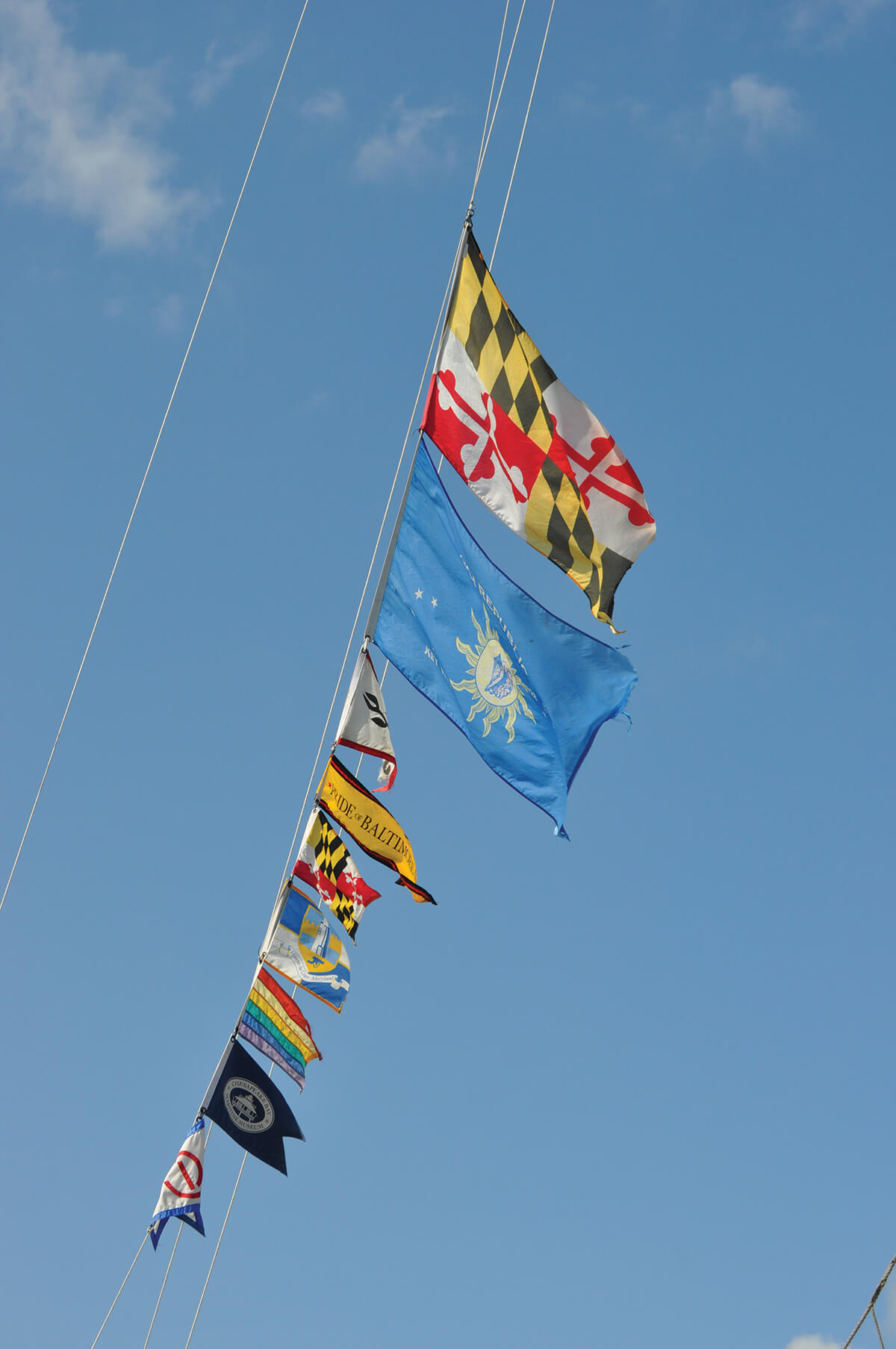
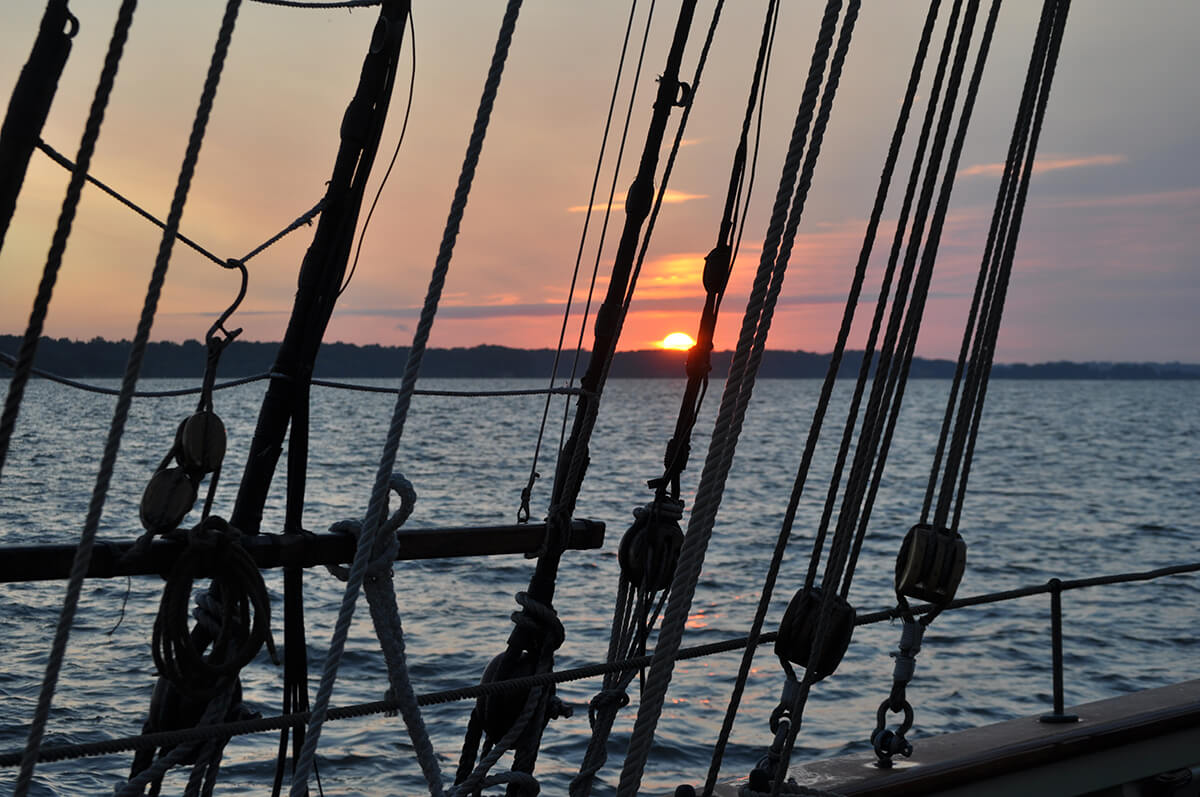
As for me, my great-great-grandfather had been a shipbuilder in Nova Scotia, where he built schooners in the second half of the 19th century. His son, also a shipbuilder and sailor, brought his family to the port of Baltimore, where my grandmother would meet my grandfather, and where my mother was eventually born. Although her brother followed in the family tradition, sailing his 36-foot sloop from Annapolis to Nova Scotia and across the Atlantic, I grew up in land-locked Iowa, and it took me years to get back to the ocean. (To the Atlantic first, for college in Maine; and two decades later to Baltimore, as imaginary reparations to my long-dead Quaker mother.)
I like to think there’s something in our DNA that ties us to the sea, like those cables of Aran sweaters women knitted both for warmth and as a way to identify their drowned fishermen. So though my seamanship was limited to kayaking and Conrad novels, I fell in love with Pride the first time I saw her docked at Broadway Pier in Fells Point and was given a free tour of the deck.
On the second day of the trip, we sailed up the Chesapeake at a slow three knots, trimming the sails to come around into a light wind as we headed toward Baltimore. The previous day we’d gone 68 miles under sail, mostly short tacking. That had meant a busy day for the crew as the boat slalomed up the Bay, notes Crosby—who is in his third season as captain, although he’d started sailing on Pride in 2008.
“Pride is fairly unique in her mission,” says Crosby, pulling at his short beard as he scans the horizon. “It’s not just ocean voyages or education day sails. And with a professional crew, you can push the boat further.”
As for the guest crews, he says they’re “to get people engaged, so it’s not just the crew members telling the story again and again.”
It’s some story, and it began not with the boat we’re sailing on, but her predecessor, the original Pride of Baltimore, which was the first Baltimore Clipper ship to be built in 150 years. Constructed in 1977 in an Inner Harbor open-air shipyard, the first Pride was a testament to Baltimore’s renaissance and shipbuilding history and inspired by the Chasseur, a topsail schooner that successfully fought against the British in the War of 1812.
The original Pride sailed around the world for nine years as an ambassador for the city before sinking in a sudden microburst squall near Puerto Rico in 1986, losing her captain and three of her crew. Shortly after the tragedy, a new ship was commissioned, both to replace the popular original and to act as a memorial to the lost crew. Built in 18 months, she launched in 1988 and has since sailed over 275,000 nautical miles around the world, visiting more than 200 ports in 40 countries.
“The mission was already established,” says Crosby and, as if to make his point, a small boat comes alongside to check us out a few moments later, with folks onboard waving and taking pictures.
This happens, says Crosby, “all the time, no matter where we are.” With seven of her 11 sails unfurled, trying to catch the wind as we make our way up the Bay on our second day out, she’s a spectacular sight, a miraculously resurrected messenger from the past.
After a stint of slow sailing and a quick lunch in the galley, Crosby and Innes direct the crew to start taking down the sails. Other deckhands make fast the system of ropes in some complex, ancient version of cat’s cradle. Stephen Plante, a barefoot deckhand from Rhode Island in a Pride “All Wood All Good” baseball cap and Aran sweater, instructs the guest crew on how to loop coils (working and dogbone coils, harpoon and ballantine coils; the list goes on).
“Nothing feels meaningless on this boat,” says Plante, who started sailing sunfishes when he was eight and crewed aboard tall ships in England before signing up on this one. “We all do all the work. You learn how to varnish, how to sand, how to sew.”
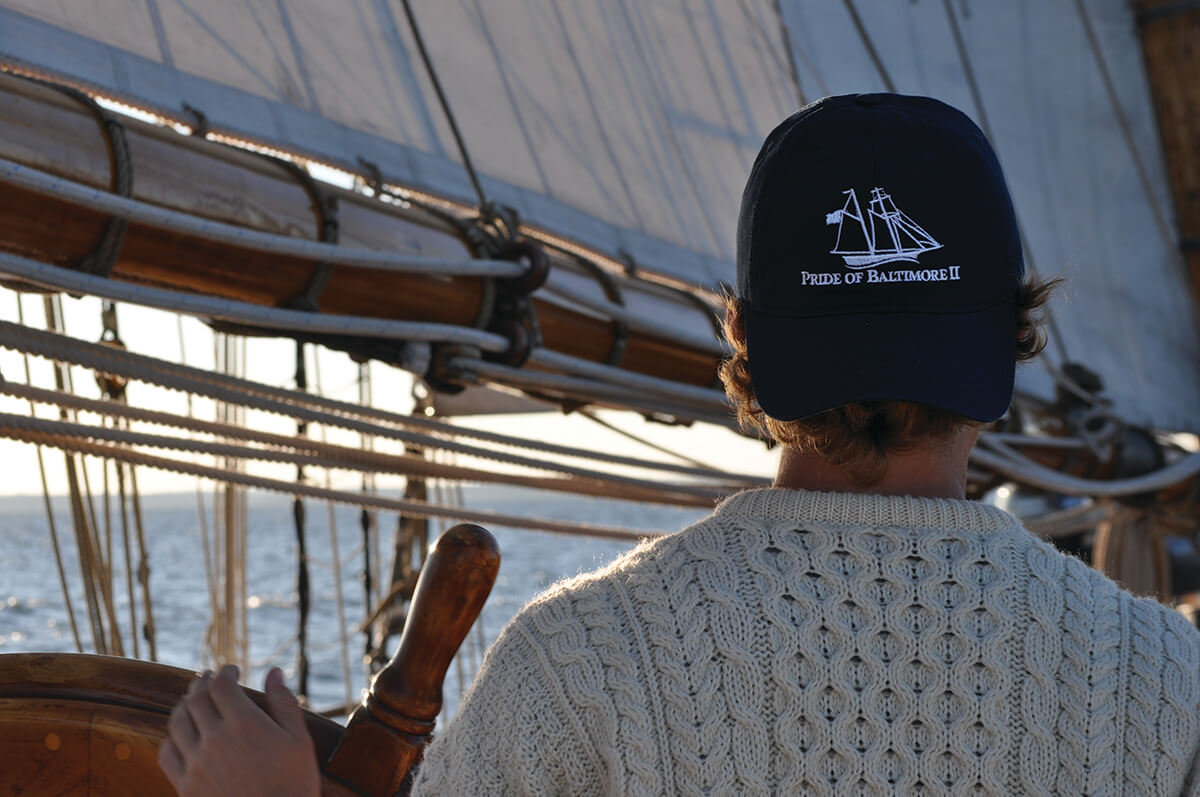
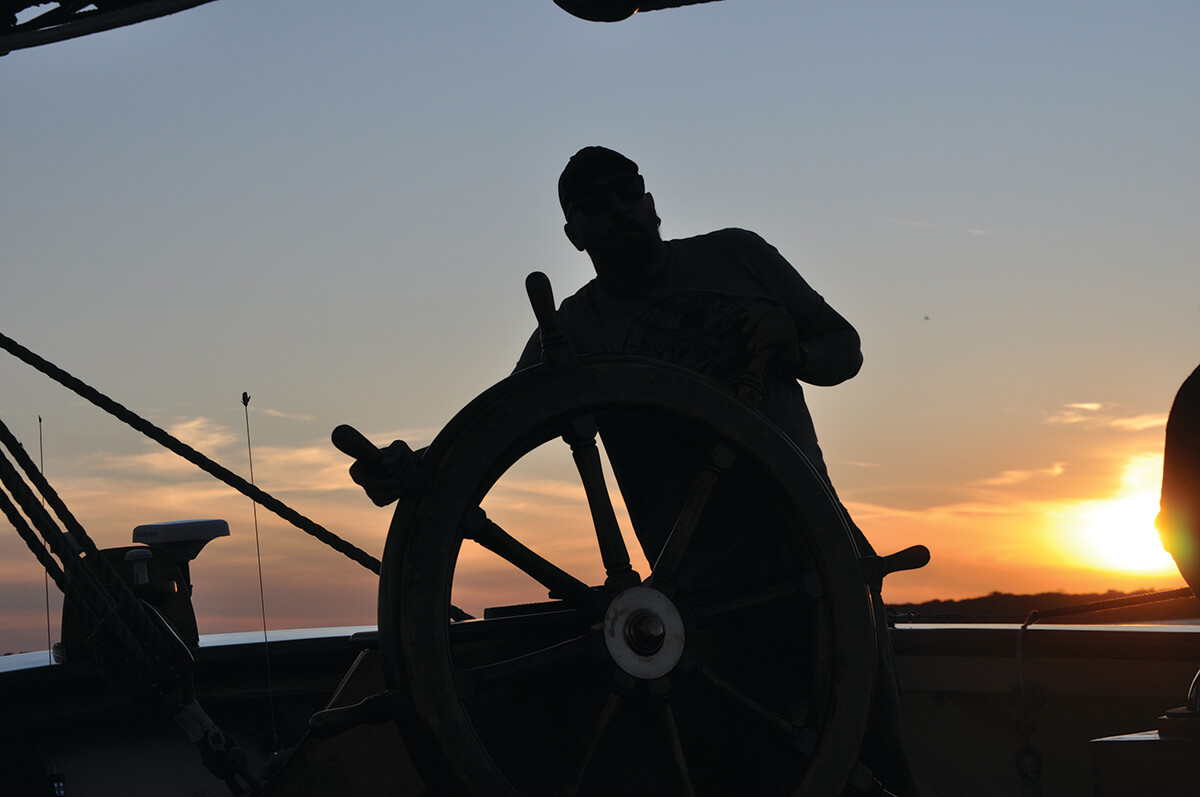
By mid-afternoon, we’re motoring—yes, Pride has modern engines, as well as a Zodiac nested atop her wooden rowboat—past Sparrows Point at 5 knots, past a tug pushing a barge of gravel from a Havre de Grace quarry. Gulls and ospreys keen and dive and we pass crab pots, their buoys and little flags like bright, regional markers.
While Pride looks like the 19th-century schooner she was built to replicate above decks, with her wooden masts and canvas sails, coils of ropes, maritime flags, four working cannons and two swivel guns, belowdecks she’s more of a circa-1960s yacht than a privateer ship.
“Do you want to spend a year of your life living in a hammock? Not so much,” says Crosby, with a small laugh.
We’ve been quartered in surprisingly comfortable double-bunk cabins; there’s a bathroom, or head, with a shower; and a roomy galley and big, wooden communal dining table.
Suzy Zahradka, a longtime sailor from Duluth, Minnesota, who’d recently signed on as the cook, is up at dawn the next morning, brewing coffee and making sheet-pan frittatas, expertly maneuvering the pots and ingredients around the space. Some supplies are kept in a tiny, refrigerated pantry; others are hidden in a compartment beneath the floor; more are stored underneath the cushioned seats wedged behind the table. Slats called fiddles keep things from sliding around the stove and the counter. She owns two small wooden boats back home and is a War of 1812 reenactor, so when she saw the opening aboard Pride, she applied.
“It’s a challenge to cook when you’re keeled over; you feel like you’re running uphill,” she says, a row of mugs slightly shaking from their hooks above her head.

The rest of the crew have journeys as idiosyncratic and seaworthy. Lucy Canfield, the bosun, a wiry 20-year-old from Erie, Pennsylvania, wearing camo pants and a belted knife sheath, has been sailing since she was 14. Her first sailing experience? A tall ship. Deckhand Emily Stringer (blonde crewcut, crab-feast T-shirt), just graduated from the College of the Atlantic with a degree in marine biology and grew up sailing on the Long Island Sound with her grandfather. She had sailed on another tall ship in the South Pacific. Listening to their stories, it’s increasingly difficult not to dream of trading in street shoes for deck boots and just staying aboard.
As we head north, past Hart-Miller Island, the mouth of the Gunpowder River, and the forested oasis of Pooles Island and its lighthouse, the oldest still standing in Maryland, Innes tasks the crew with myriad chores that the break in sailing allows—checking machinery, repairing lines, and, yes, scrubbing the deck.
Innes is on her third stint aboard Pride, having been first mate since 2022, second mate a few seasons before that, and, back in 2008, a deckhand along with Crosby. In between sailing contracts, she’d been a professional roller derby skater.
“I love the people who choose to do this with their lives. They’re some of the most capable, competent, community-oriented people I’ve ever met,” she says. “I also really enjoy the athleticism of traditional sailing; it’s a living craft. But I also just love this boat.”
It’s a feeling palpably shared by the rest of the crew—as well as me and the other two novices, who’ve been trailing the deckhands around, looping ropes and hauling lines like eager children.
With calm skies and water, O’Brien and I gear up in harnesses and climb the shrouds after the crew, ascending the rope ladders to help secure the sails along the yard. It’s more fun than frightening, an airborne jungle gym, and the Bay falls away into the horizon below, the isosceles triangle of the boat’s prow like a toy ship in a dark blue bathtub.
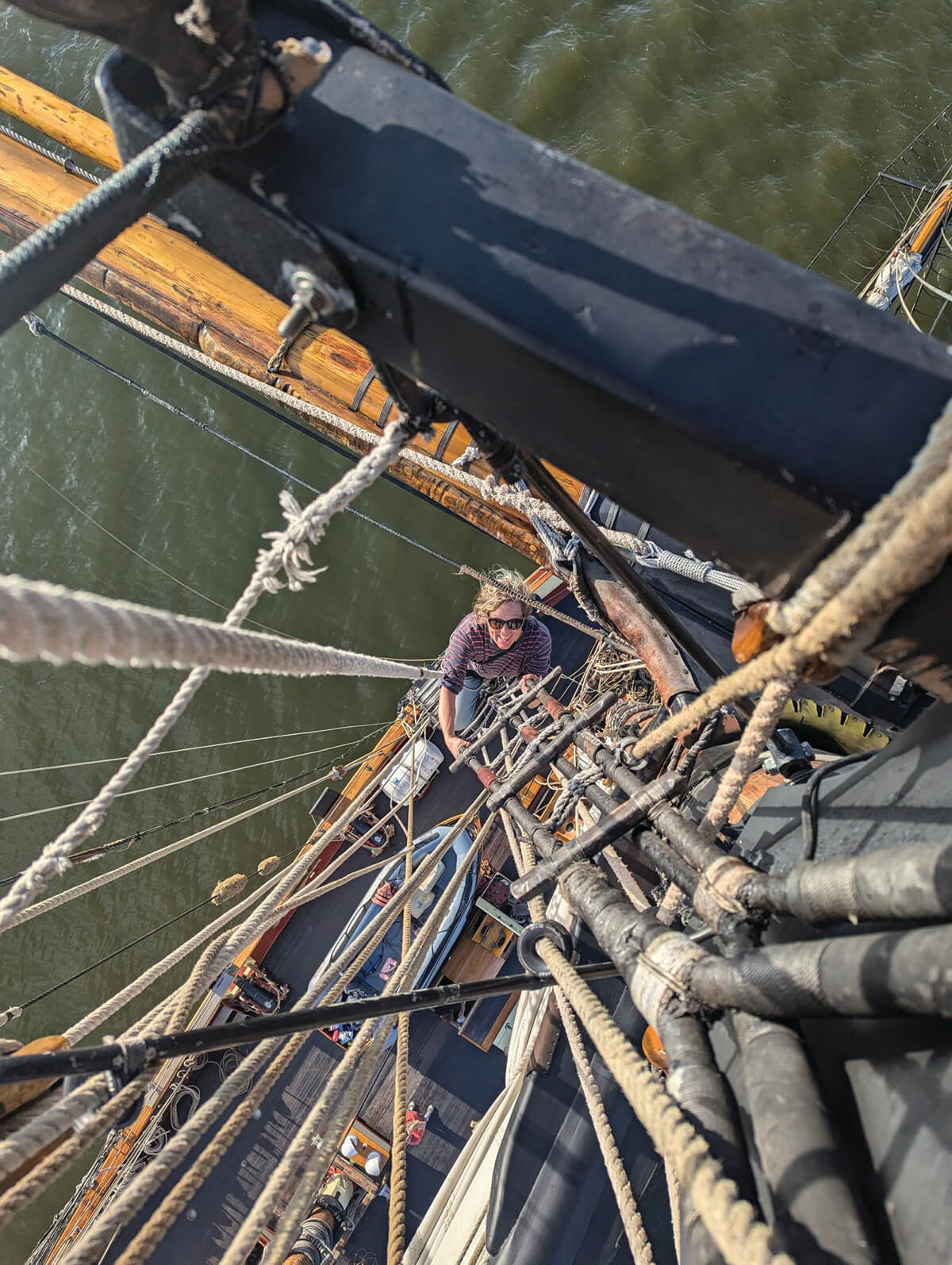
On the final morning of the sail, Crosby turns his attention to the cannons. Defenders Day, a longtime commemoration celebrating the city’s successful 1814 defense against British invasion forces, is coming up. Pride will be firing her cannons for the event, and the crew needs the practice. This being considerably more fun than swabbing the decks, everyone gathers to assemble the gear from a locked box: cannon pins, explosive charges, a museum-worthy powder horn, and tools to pack the charge.
As with every move on the boat, both orders and replies are called out, a nautical version of the ecclesiastical call and response. The cannons are loaded and Kai Joswig, a deckhand from Belize in a tie-dyed T-shirt, dons protective glasses and earmuffs and lights the first one. He’s wielding the kind of propane torch you’d find at a Home Depot, a surprising but oddly satisfying touch.
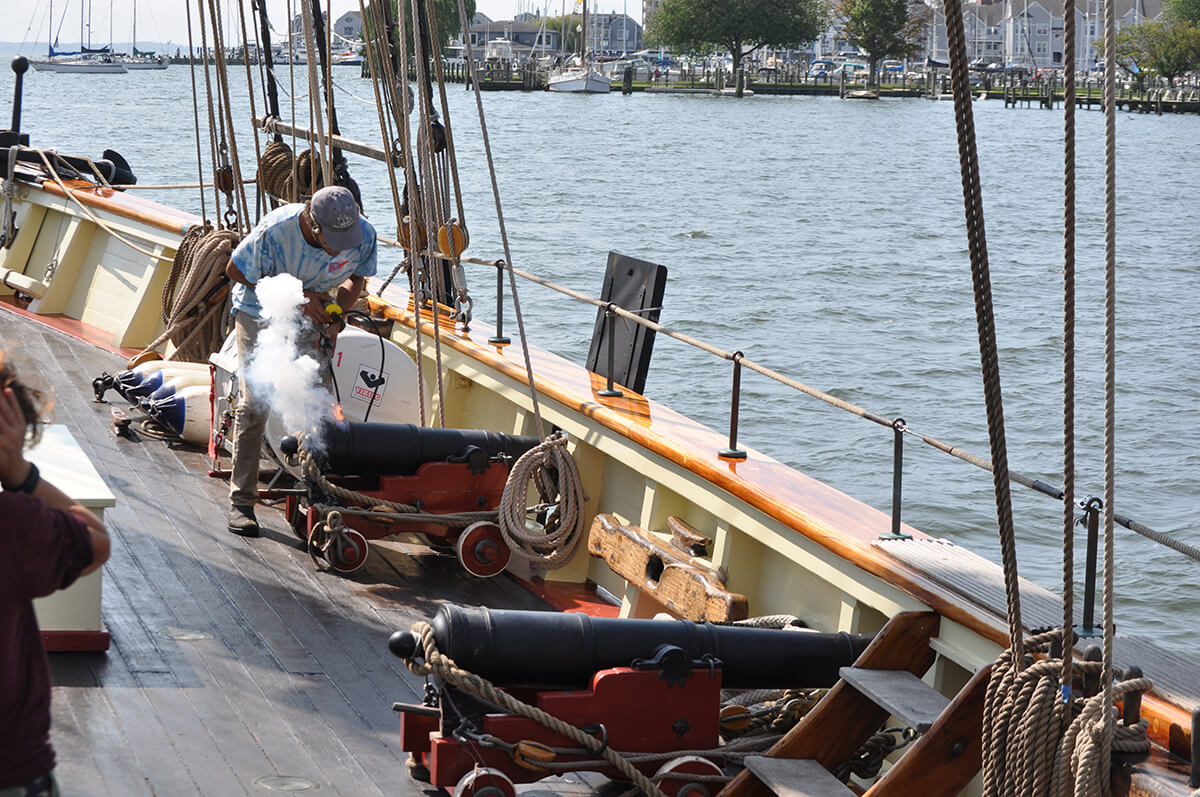
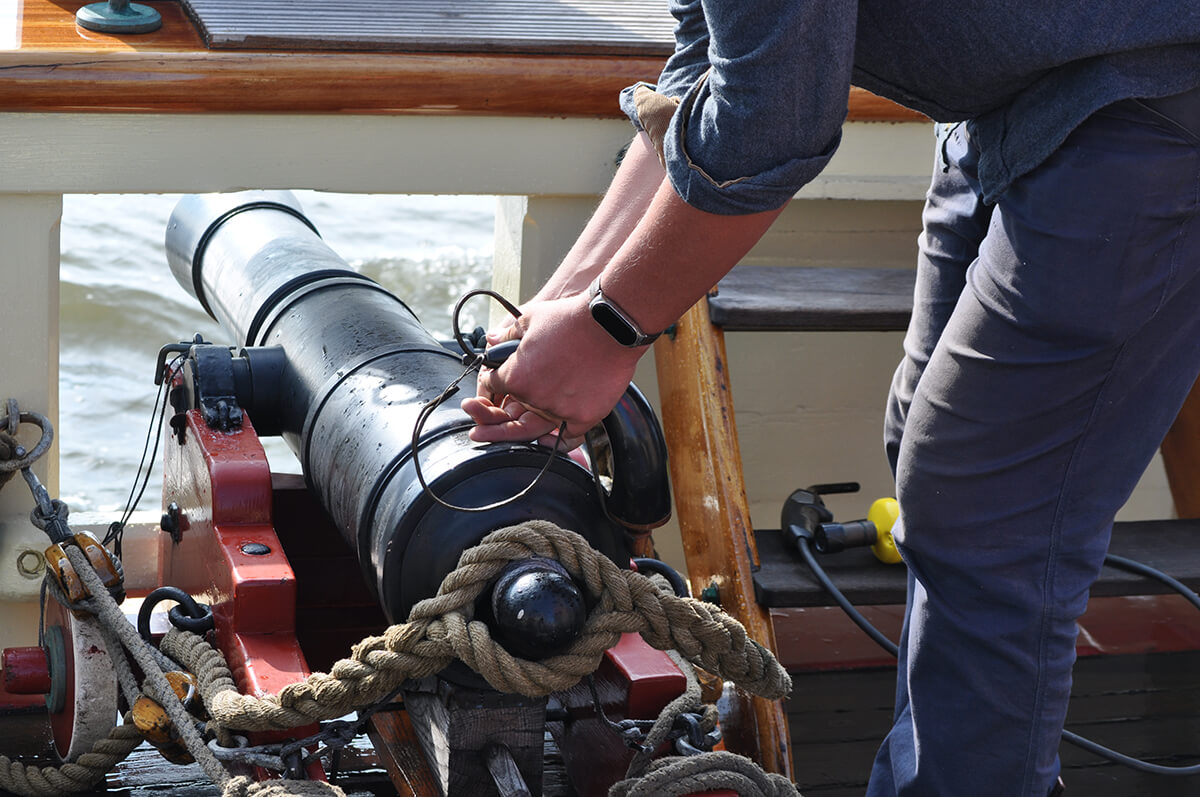
“To make a little noise,” the captain says with a smile, “but also to test them, since they haven’t been fired in a bit.”
As we near Havre de Grace, we fire the last of the cannons. A thick plume of white smoke forms its own weather system out into the sunlit harbor. The flags are lowered, and all the lines and ropes and pullies across the deck seem to moor the boat not only to the land again, but to tether the past to the present—the history of shipbuilding and sailing secured to all the harbors down the Chesapeake.